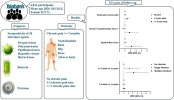Pathogen-specific exposure is associated with multisite chronic pain: A prospective cohort study
Jialiu Fang, Zemene Demelash Kifle, Jing Tian, Silvana Bettiol, Flavia Cicuttini, Graeme Jones, Feng Pan
[Line breaks added]
Abstract
Evidence suggests that pathogens may influence pain perception and regulation; however, no study has explored the relationship between serological evidence of infection and multisite chronic musculoskeletal pain. Therefore, this study aimed to investigate the association between serological evidence of infection and multisite chronic musculoskeletal pain.
Participants (n = 6,814; mean [SD]age, 56.5[8.2] years; females [52.9 %]) in the UK Biobank were included. Multiplex serology panel measuring serum immunoglobulin G antibody levels against 20 infectious agents was performed at baseline. Chronic pain (≥3 months) in the knee, neck/shoulder, hip, back, or ‘all over the body’ was assessed at baseline and follow-up. Participants were grouped by number of chronic pain sites: no chronic pain, chronic pain in 1–2 sites, or ≥3 sites. Multinomial logistic regression and mixed-effect multinomial logistic regression models were used for the analyses.
The seroprevalences of serologically detected infections across the 20 agents ranged from 0.2 % to 95.4 %. In multivariable analyses, serological evidence of infection with Epstein-Barr Virus (EBV), Human T-Cell Lymphotropic Virus Type-1 (HTLV-1), and Chlamydia Trachomatis was cross-sectionally associated with chronic pain in ≥3 sites compared to those without chronic pain.
In longitudinal analyses, EBV [relative risk ratio (RRR) = 2.18, 95 %CI:1.17 − 4.05] and Chlamydia Trachomatis [RRR = 1.38, 95 %CI:1.09 − 1.74] were also associated with chronic pain in ≥3 sites. Additionally, serological evidence of single and multiple infections was associated with chronic pain in ≥3 sites, but not in 1–2 sites.
Collectively, serological evidence of infection with EBV and Chlamydia Trachomatis is associated with multisite chronic musculoskeletal pain. These findings suggest that infectious agents may play a role in the pathogenesis of widespread chronic pain.
Link | PDF (Brain, Behavior, and Immunity) [Open Access]
Jialiu Fang, Zemene Demelash Kifle, Jing Tian, Silvana Bettiol, Flavia Cicuttini, Graeme Jones, Feng Pan
[Line breaks added]
Abstract
Evidence suggests that pathogens may influence pain perception and regulation; however, no study has explored the relationship between serological evidence of infection and multisite chronic musculoskeletal pain. Therefore, this study aimed to investigate the association between serological evidence of infection and multisite chronic musculoskeletal pain.
Participants (n = 6,814; mean [SD]age, 56.5[8.2] years; females [52.9 %]) in the UK Biobank were included. Multiplex serology panel measuring serum immunoglobulin G antibody levels against 20 infectious agents was performed at baseline. Chronic pain (≥3 months) in the knee, neck/shoulder, hip, back, or ‘all over the body’ was assessed at baseline and follow-up. Participants were grouped by number of chronic pain sites: no chronic pain, chronic pain in 1–2 sites, or ≥3 sites. Multinomial logistic regression and mixed-effect multinomial logistic regression models were used for the analyses.
The seroprevalences of serologically detected infections across the 20 agents ranged from 0.2 % to 95.4 %. In multivariable analyses, serological evidence of infection with Epstein-Barr Virus (EBV), Human T-Cell Lymphotropic Virus Type-1 (HTLV-1), and Chlamydia Trachomatis was cross-sectionally associated with chronic pain in ≥3 sites compared to those without chronic pain.
In longitudinal analyses, EBV [relative risk ratio (RRR) = 2.18, 95 %CI:1.17 − 4.05] and Chlamydia Trachomatis [RRR = 1.38, 95 %CI:1.09 − 1.74] were also associated with chronic pain in ≥3 sites. Additionally, serological evidence of single and multiple infections was associated with chronic pain in ≥3 sites, but not in 1–2 sites.
Collectively, serological evidence of infection with EBV and Chlamydia Trachomatis is associated with multisite chronic musculoskeletal pain. These findings suggest that infectious agents may play a role in the pathogenesis of widespread chronic pain.
Link | PDF (Brain, Behavior, and Immunity) [Open Access]

